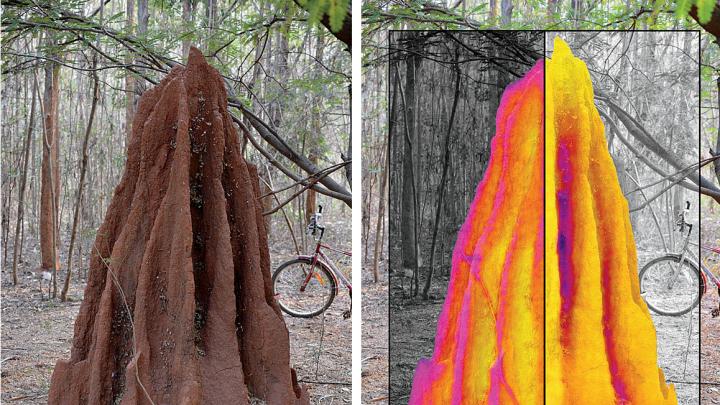Looming meters tall, dotting hot climates on four continents, termite mounds have long mystified scientists. In each colony’s underground nest, the millimeter-sized insects store wood for food, cultivate the fungus that helps digestion, rear young, and tend to their queen. Yet the porous, cathedral-like mounds they build from soil and their own saliva and dung remain enigmatically empty.
In September, Harvard physicists published research asserting that the “cathedral” mounds built by Odontotermes obesus, in southern India, function as aboveground “lungs.” The mounds’ architecture features a large central chimney, where the temperature remains relatively constant, surrounded by thin outer flutes where temperatures fluctuate. During the daytime, these outer conduits heat up much more quickly than the internal chamber, forcing air up the flutes and down the chimney. At night, the process reverses, with air going up the chimney and down the flutes.
This process also ventilates the underground gallery where the colony lives and works. The scientists initially expected near-constant gas exchange that halted only when the convection cell reversed its direction twice a day. What they found when they measured carbon dioxide concentration levels surprised them. Because the top of the mound is hotter than the nest, keeping internal airflows due to convection small, the gas actually builds up during the day. But when the upper mound cools at night, relatively warmer air from the subterranean nest rises and diffuses through the walls. Stagnant air thus flushes out of the nest, reports researcher Sam Ocko: “We sometimes call it ‘the sneeze event.’”
A now-debunked but long-accepted theory, proposed in 1960 by Swiss entomologist Martin Lüscher, had claimed that the mound served as an air conditioner for the nest below, with the termites’ metabolic activity driving heated, stale air out from the center. (The Eastgate Centre in Harare, Zimbabwe, built in 1996, modeled its cooling and ventilation system on this supposed insect-inspired innovation.) More recently, SUNY biology professor J. Scott Turner—after years of research during which he pumped mounds with tracer gas, scanned them with lasers, and filled them with plaster—suggested a different hypothesis: that the mound manipulates external wind and the transient energy in its turbulence via intricate internal tunnels that “sloshed” fresh air in. In collaboration with Turner, Harvard’s de Valpine professor of applied mathematics, Lakshminarayanan “Maha” Mahadevan, and postdoctoral fellows Ocko and Hunter King, decided to try another approach—directly measuring the airflows inside a mound. (For more about Mahadevan’s work, see “The Physics of the Familiar,” March-April 2008, page 48.)
Easier said than done. In the mound, air moves slowly—and because “measuring slowly moving air is not something that people normally try to do,” King explains, commercial sensors couldn’t do the job. The complex geometry of the confined, opaque chambers posed an additional challenge. Then there were the mound’s residents: the colony’s soldiers rush to repel any intrusion, emitting a gluey, corrosive saliva onto the probe or attacking it with their mandibles. The team had to custom-design a sensor—something “very sensitive, calibrateable in these funny geometries, and very cheap, because you’re going to lose it every once in a while,” reports King—which they inserted into the mound after boring in with a hole saw.
They also adopted a strategy of what Ocko calls “hit-and-run measurements,” never lingering for more than five minutes and never poking into the same location twice, to avoid interrupting termite repairs. They also carried around a bucket of mound material and water for sealing the holes back up, “just as a courtesy,” says King. During their weeks in Bangalore, they bushwhacked through the forest to find more mounds to study, stomping to scare snakes out from underfoot. By the end, they’d taken around 80 measurements across 25 living and dead mounds. Investigating gas exchange was less hectic: King kept vigil for almost 24 hours by a mound, measuring carbon-dioxide levels every 15 minutes while snacking on the fruit of a nearby tamarind tree. (As termite lore goes, this is nothing: the poet who wrote the Ramayana is said to have meditated for so long that the insects built a mound around his body, and he had to be dug out by a passing sage.)
The resulting view into termite ventilation is particularly striking: the system uses oscillations, harnessing change itself. “Getting useful work out of a varying parameter, like temperature, is a novel mechanism,” King says, because “that’s not how things are usually engineered for humans,” who typically extract energy (whether from winds, waves, or the sun’s heat) from unidirectional flow.
To test whether these mechanisms are generalizable across species, the researchers are working on a paper about different mound-building termites, in Namibia. Their mounds endure more dramatic temperature extremes, Ocko reports, as well as daylong, full-sun exposure, which heats the sides of the mound unevenly. Additionally, this species produces a different mound shape—conical, without buttresses—and the reasons for the divergence in architecture remain unknown. “One question that we don’t have a good handle on is, why do some of them look one way, and some of them look another way?” says Ocko. “From an evolutionary perspective, are some strategies better at some times, and other strategies better in other places? Or is this some byproduct of termite behavior?”
Insights from termite behavior may prove useful to human engineers, from architects trying to design more efficient buildings to computer scientists interested in swarm intelligence. In the larger biological picture of how local decisions give rise to complex behavior, understanding the mound—knowing what solution these tiny, silent insects sought for their environment—is a vital piece.








